Critically Assessing Restorative Justice
VerifiedAdded on 2023/06/12
|13
|4272
|346
AI Summary
This essay critically assesses the concept of restorative justice, its implementation in the criminal justice system, and its impact on victims. It discusses the use of restorative justice in dealing with offenders, the position of victims in cases of serious offenses, power imbalances, and risks to the rights of victims. The essay also explores the concept of good and bad victims and the challenges faced by victims in the criminal justice system.
Contribute Materials
Your contribution can guide someone’s learning journey. Share your
documents today.
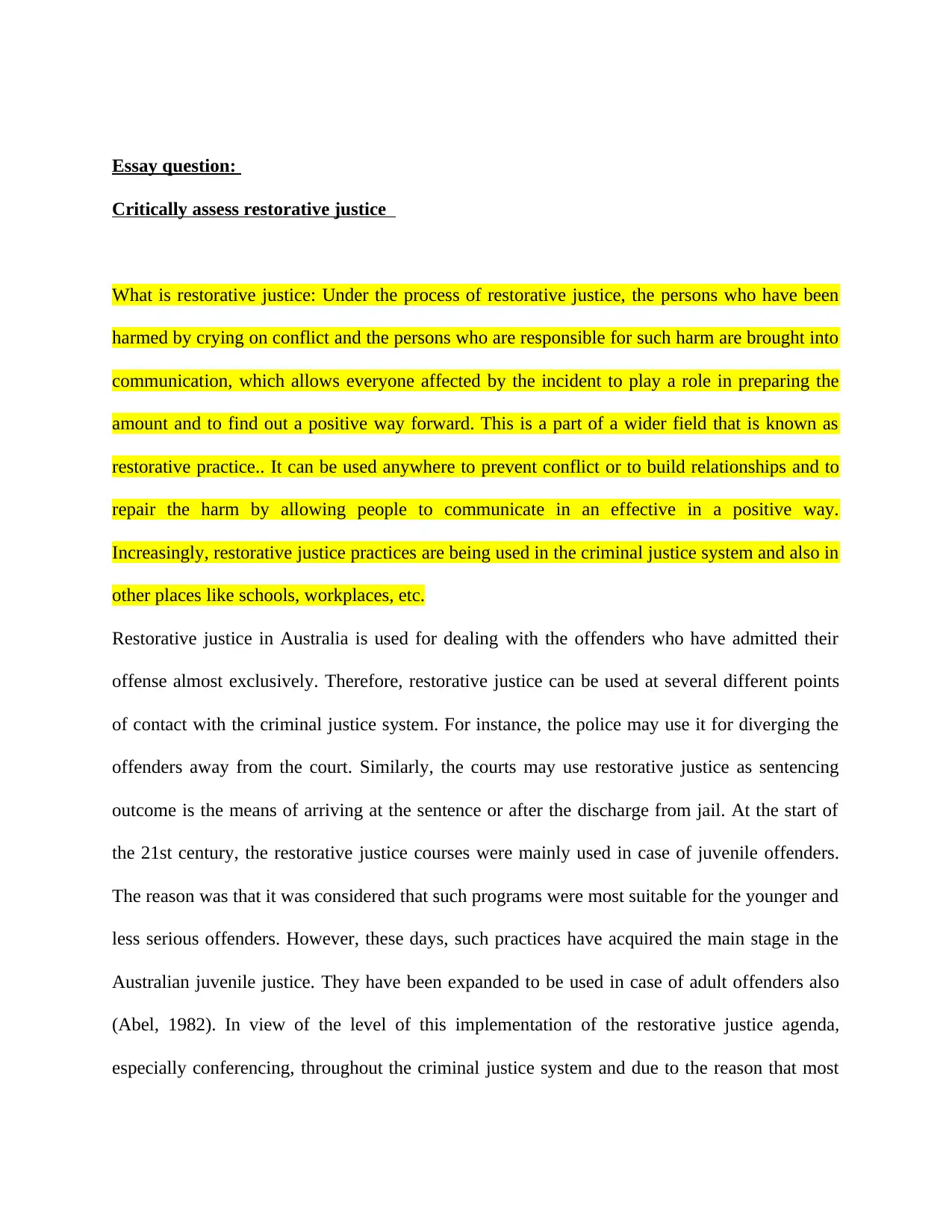
Essay question:
Critically assess restorative justice
What is restorative justice: Under the process of restorative justice, the persons who have been
harmed by crying on conflict and the persons who are responsible for such harm are brought into
communication, which allows everyone affected by the incident to play a role in preparing the
amount and to find out a positive way forward. This is a part of a wider field that is known as
restorative practice.. It can be used anywhere to prevent conflict or to build relationships and to
repair the harm by allowing people to communicate in an effective in a positive way.
Increasingly, restorative justice practices are being used in the criminal justice system and also in
other places like schools, workplaces, etc.
Restorative justice in Australia is used for dealing with the offenders who have admitted their
offense almost exclusively. Therefore, restorative justice can be used at several different points
of contact with the criminal justice system. For instance, the police may use it for diverging the
offenders away from the court. Similarly, the courts may use restorative justice as sentencing
outcome is the means of arriving at the sentence or after the discharge from jail. At the start of
the 21st century, the restorative justice courses were mainly used in case of juvenile offenders.
The reason was that it was considered that such programs were most suitable for the younger and
less serious offenders. However, these days, such practices have acquired the main stage in the
Australian juvenile justice. They have been expanded to be used in case of adult offenders also
(Abel, 1982). In view of the level of this implementation of the restorative justice agenda,
especially conferencing, throughout the criminal justice system and due to the reason that most
Critically assess restorative justice
What is restorative justice: Under the process of restorative justice, the persons who have been
harmed by crying on conflict and the persons who are responsible for such harm are brought into
communication, which allows everyone affected by the incident to play a role in preparing the
amount and to find out a positive way forward. This is a part of a wider field that is known as
restorative practice.. It can be used anywhere to prevent conflict or to build relationships and to
repair the harm by allowing people to communicate in an effective in a positive way.
Increasingly, restorative justice practices are being used in the criminal justice system and also in
other places like schools, workplaces, etc.
Restorative justice in Australia is used for dealing with the offenders who have admitted their
offense almost exclusively. Therefore, restorative justice can be used at several different points
of contact with the criminal justice system. For instance, the police may use it for diverging the
offenders away from the court. Similarly, the courts may use restorative justice as sentencing
outcome is the means of arriving at the sentence or after the discharge from jail. At the start of
the 21st century, the restorative justice courses were mainly used in case of juvenile offenders.
The reason was that it was considered that such programs were most suitable for the younger and
less serious offenders. However, these days, such practices have acquired the main stage in the
Australian juvenile justice. They have been expanded to be used in case of adult offenders also
(Abel, 1982). In view of the level of this implementation of the restorative justice agenda,
especially conferencing, throughout the criminal justice system and due to the reason that most
Secure Best Marks with AI Grader
Need help grading? Try our AI Grader for instant feedback on your assignments.
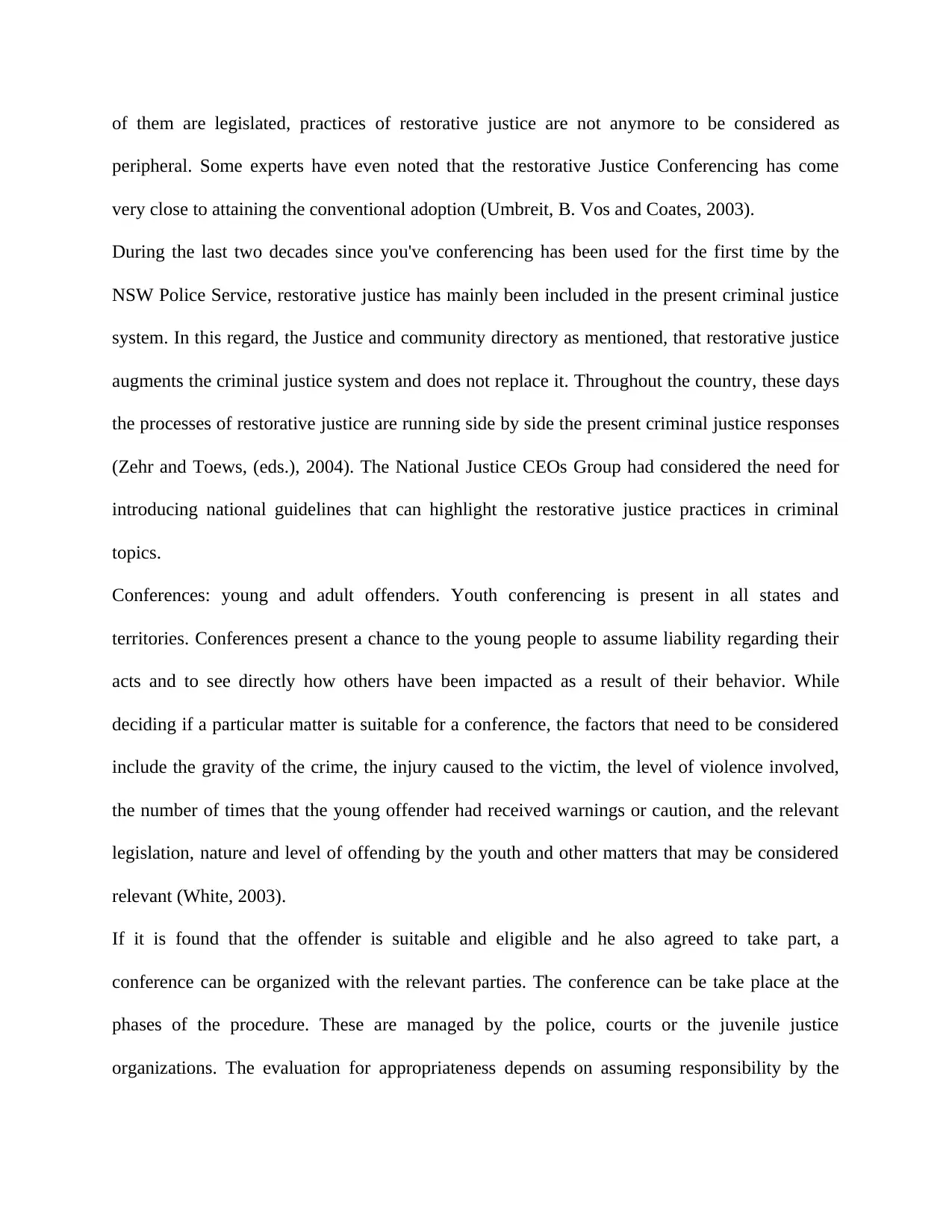
of them are legislated, practices of restorative justice are not anymore to be considered as
peripheral. Some experts have even noted that the restorative Justice Conferencing has come
very close to attaining the conventional adoption (Umbreit, B. Vos and Coates, 2003).
During the last two decades since you've conferencing has been used for the first time by the
NSW Police Service, restorative justice has mainly been included in the present criminal justice
system. In this regard, the Justice and community directory as mentioned, that restorative justice
augments the criminal justice system and does not replace it. Throughout the country, these days
the processes of restorative justice are running side by side the present criminal justice responses
(Zehr and Toews, (eds.), 2004). The National Justice CEOs Group had considered the need for
introducing national guidelines that can highlight the restorative justice practices in criminal
topics.
Conferences: young and adult offenders. Youth conferencing is present in all states and
territories. Conferences present a chance to the young people to assume liability regarding their
acts and to see directly how others have been impacted as a result of their behavior. While
deciding if a particular matter is suitable for a conference, the factors that need to be considered
include the gravity of the crime, the injury caused to the victim, the level of violence involved,
the number of times that the young offender had received warnings or caution, and the relevant
legislation, nature and level of offending by the youth and other matters that may be considered
relevant (White, 2003).
If it is found that the offender is suitable and eligible and he also agreed to take part, a
conference can be organized with the relevant parties. The conference can be take place at the
phases of the procedure. These are managed by the police, courts or the juvenile justice
organizations. The evaluation for appropriateness depends on assuming responsibility by the
peripheral. Some experts have even noted that the restorative Justice Conferencing has come
very close to attaining the conventional adoption (Umbreit, B. Vos and Coates, 2003).
During the last two decades since you've conferencing has been used for the first time by the
NSW Police Service, restorative justice has mainly been included in the present criminal justice
system. In this regard, the Justice and community directory as mentioned, that restorative justice
augments the criminal justice system and does not replace it. Throughout the country, these days
the processes of restorative justice are running side by side the present criminal justice responses
(Zehr and Toews, (eds.), 2004). The National Justice CEOs Group had considered the need for
introducing national guidelines that can highlight the restorative justice practices in criminal
topics.
Conferences: young and adult offenders. Youth conferencing is present in all states and
territories. Conferences present a chance to the young people to assume liability regarding their
acts and to see directly how others have been impacted as a result of their behavior. While
deciding if a particular matter is suitable for a conference, the factors that need to be considered
include the gravity of the crime, the injury caused to the victim, the level of violence involved,
the number of times that the young offender had received warnings or caution, and the relevant
legislation, nature and level of offending by the youth and other matters that may be considered
relevant (White, 2003).
If it is found that the offender is suitable and eligible and he also agreed to take part, a
conference can be organized with the relevant parties. The conference can be take place at the
phases of the procedure. These are managed by the police, courts or the juvenile justice
organizations. The evaluation for appropriateness depends on assuming responsibility by the
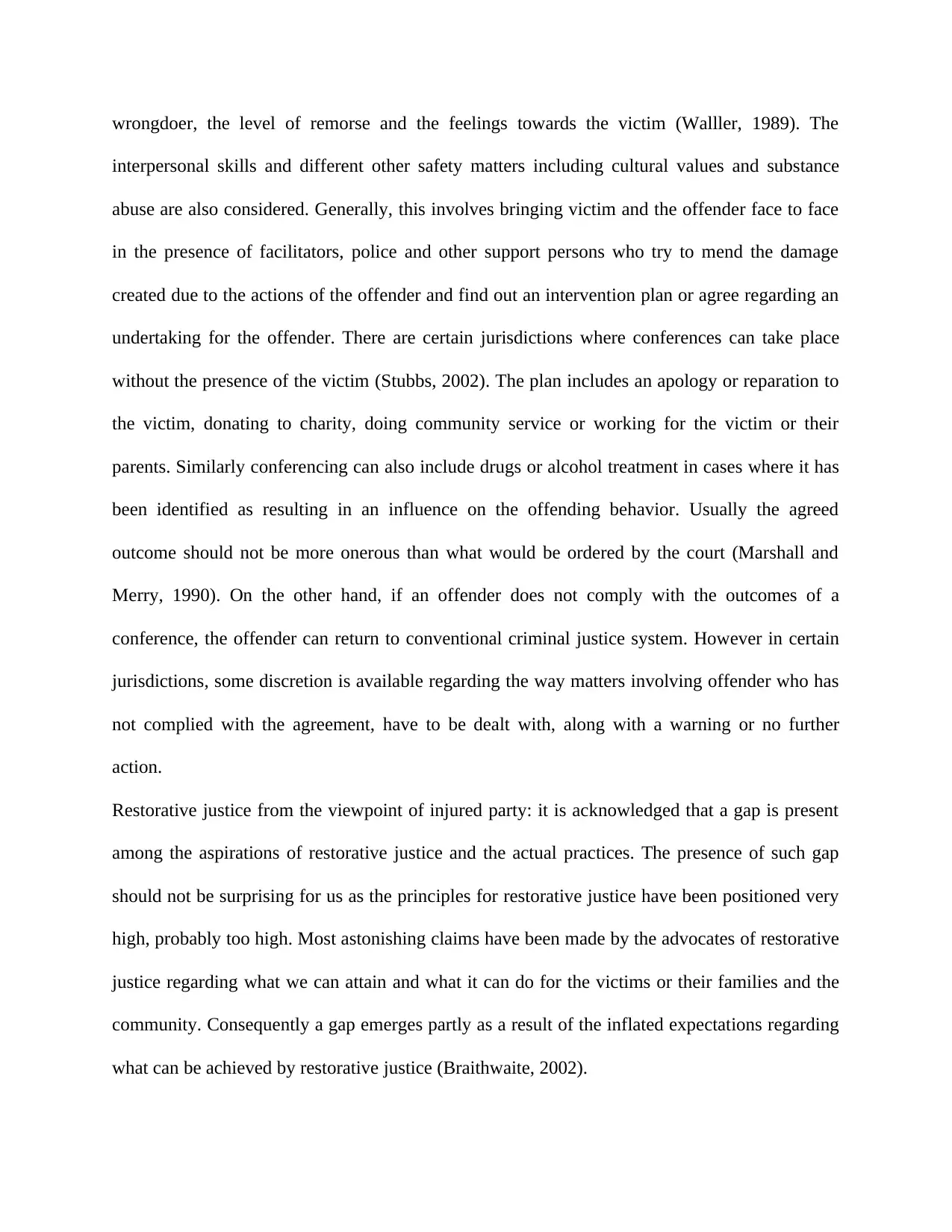
wrongdoer, the level of remorse and the feelings towards the victim (Walller, 1989). The
interpersonal skills and different other safety matters including cultural values and substance
abuse are also considered. Generally, this involves bringing victim and the offender face to face
in the presence of facilitators, police and other support persons who try to mend the damage
created due to the actions of the offender and find out an intervention plan or agree regarding an
undertaking for the offender. There are certain jurisdictions where conferences can take place
without the presence of the victim (Stubbs, 2002). The plan includes an apology or reparation to
the victim, donating to charity, doing community service or working for the victim or their
parents. Similarly conferencing can also include drugs or alcohol treatment in cases where it has
been identified as resulting in an influence on the offending behavior. Usually the agreed
outcome should not be more onerous than what would be ordered by the court (Marshall and
Merry, 1990). On the other hand, if an offender does not comply with the outcomes of a
conference, the offender can return to conventional criminal justice system. However in certain
jurisdictions, some discretion is available regarding the way matters involving offender who has
not complied with the agreement, have to be dealt with, along with a warning or no further
action.
Restorative justice from the viewpoint of injured party: it is acknowledged that a gap is present
among the aspirations of restorative justice and the actual practices. The presence of such gap
should not be surprising for us as the principles for restorative justice have been positioned very
high, probably too high. Most astonishing claims have been made by the advocates of restorative
justice regarding what we can attain and what it can do for the victims or their families and the
community. Consequently a gap emerges partly as a result of the inflated expectations regarding
what can be achieved by restorative justice (Braithwaite, 2002).
interpersonal skills and different other safety matters including cultural values and substance
abuse are also considered. Generally, this involves bringing victim and the offender face to face
in the presence of facilitators, police and other support persons who try to mend the damage
created due to the actions of the offender and find out an intervention plan or agree regarding an
undertaking for the offender. There are certain jurisdictions where conferences can take place
without the presence of the victim (Stubbs, 2002). The plan includes an apology or reparation to
the victim, donating to charity, doing community service or working for the victim or their
parents. Similarly conferencing can also include drugs or alcohol treatment in cases where it has
been identified as resulting in an influence on the offending behavior. Usually the agreed
outcome should not be more onerous than what would be ordered by the court (Marshall and
Merry, 1990). On the other hand, if an offender does not comply with the outcomes of a
conference, the offender can return to conventional criminal justice system. However in certain
jurisdictions, some discretion is available regarding the way matters involving offender who has
not complied with the agreement, have to be dealt with, along with a warning or no further
action.
Restorative justice from the viewpoint of injured party: it is acknowledged that a gap is present
among the aspirations of restorative justice and the actual practices. The presence of such gap
should not be surprising for us as the principles for restorative justice have been positioned very
high, probably too high. Most astonishing claims have been made by the advocates of restorative
justice regarding what we can attain and what it can do for the victims or their families and the
community. Consequently a gap emerges partly as a result of the inflated expectations regarding
what can be achieved by restorative justice (Braithwaite, 2002).
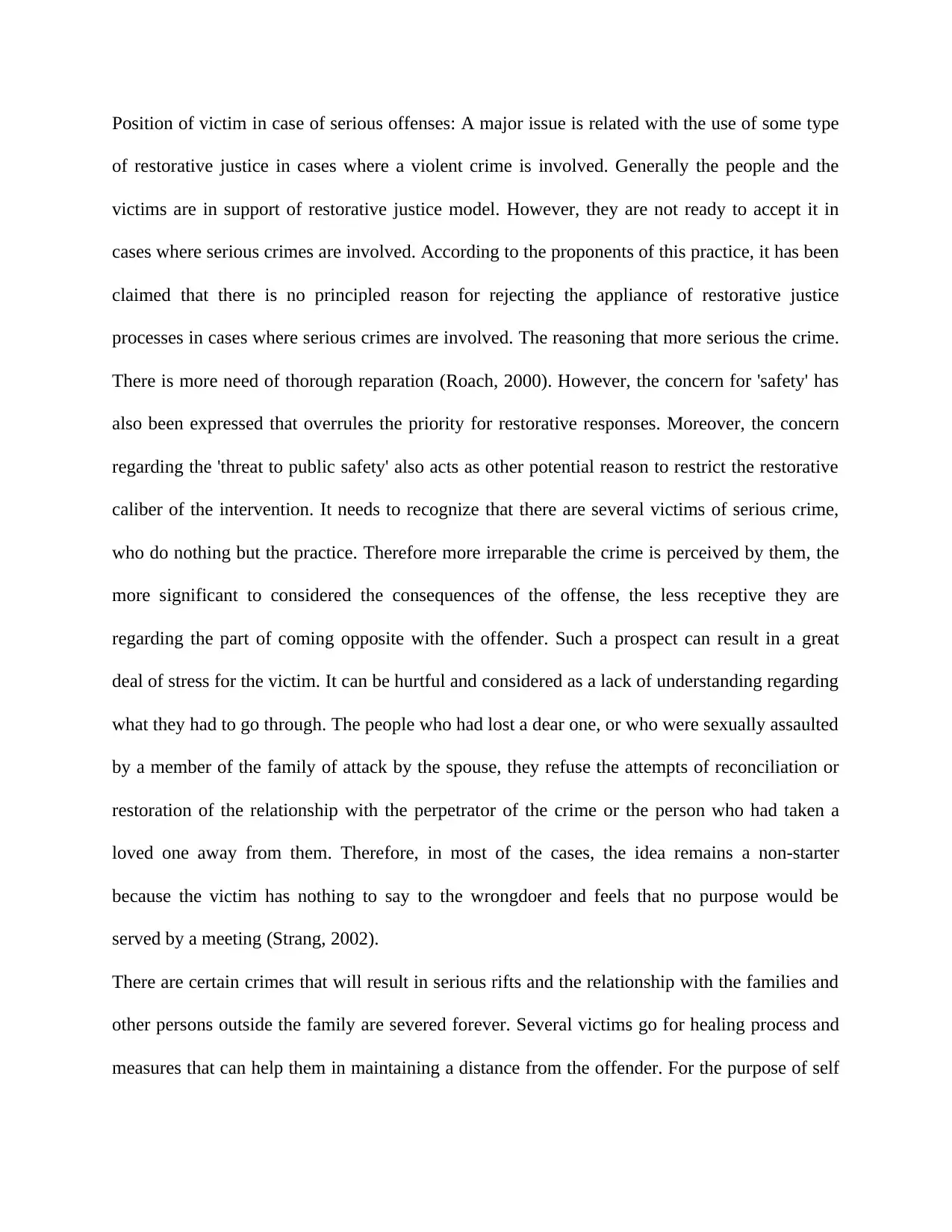
Position of victim in case of serious offenses: A major issue is related with the use of some type
of restorative justice in cases where a violent crime is involved. Generally the people and the
victims are in support of restorative justice model. However, they are not ready to accept it in
cases where serious crimes are involved. According to the proponents of this practice, it has been
claimed that there is no principled reason for rejecting the appliance of restorative justice
processes in cases where serious crimes are involved. The reasoning that more serious the crime.
There is more need of thorough reparation (Roach, 2000). However, the concern for 'safety' has
also been expressed that overrules the priority for restorative responses. Moreover, the concern
regarding the 'threat to public safety' also acts as other potential reason to restrict the restorative
caliber of the intervention. It needs to recognize that there are several victims of serious crime,
who do nothing but the practice. Therefore more irreparable the crime is perceived by them, the
more significant to considered the consequences of the offense, the less receptive they are
regarding the part of coming opposite with the offender. Such a prospect can result in a great
deal of stress for the victim. It can be hurtful and considered as a lack of understanding regarding
what they had to go through. The people who had lost a dear one, or who were sexually assaulted
by a member of the family of attack by the spouse, they refuse the attempts of reconciliation or
restoration of the relationship with the perpetrator of the crime or the person who had taken a
loved one away from them. Therefore, in most of the cases, the idea remains a non-starter
because the victim has nothing to say to the wrongdoer and feels that no purpose would be
served by a meeting (Strang, 2002).
There are certain crimes that will result in serious rifts and the relationship with the families and
other persons outside the family are severed forever. Several victims go for healing process and
measures that can help them in maintaining a distance from the offender. For the purpose of self
of restorative justice in cases where a violent crime is involved. Generally the people and the
victims are in support of restorative justice model. However, they are not ready to accept it in
cases where serious crimes are involved. According to the proponents of this practice, it has been
claimed that there is no principled reason for rejecting the appliance of restorative justice
processes in cases where serious crimes are involved. The reasoning that more serious the crime.
There is more need of thorough reparation (Roach, 2000). However, the concern for 'safety' has
also been expressed that overrules the priority for restorative responses. Moreover, the concern
regarding the 'threat to public safety' also acts as other potential reason to restrict the restorative
caliber of the intervention. It needs to recognize that there are several victims of serious crime,
who do nothing but the practice. Therefore more irreparable the crime is perceived by them, the
more significant to considered the consequences of the offense, the less receptive they are
regarding the part of coming opposite with the offender. Such a prospect can result in a great
deal of stress for the victim. It can be hurtful and considered as a lack of understanding regarding
what they had to go through. The people who had lost a dear one, or who were sexually assaulted
by a member of the family of attack by the spouse, they refuse the attempts of reconciliation or
restoration of the relationship with the perpetrator of the crime or the person who had taken a
loved one away from them. Therefore, in most of the cases, the idea remains a non-starter
because the victim has nothing to say to the wrongdoer and feels that no purpose would be
served by a meeting (Strang, 2002).
There are certain crimes that will result in serious rifts and the relationship with the families and
other persons outside the family are severed forever. Several victims go for healing process and
measures that can help them in maintaining a distance from the offender. For the purpose of self
Secure Best Marks with AI Grader
Need help grading? Try our AI Grader for instant feedback on your assignments.
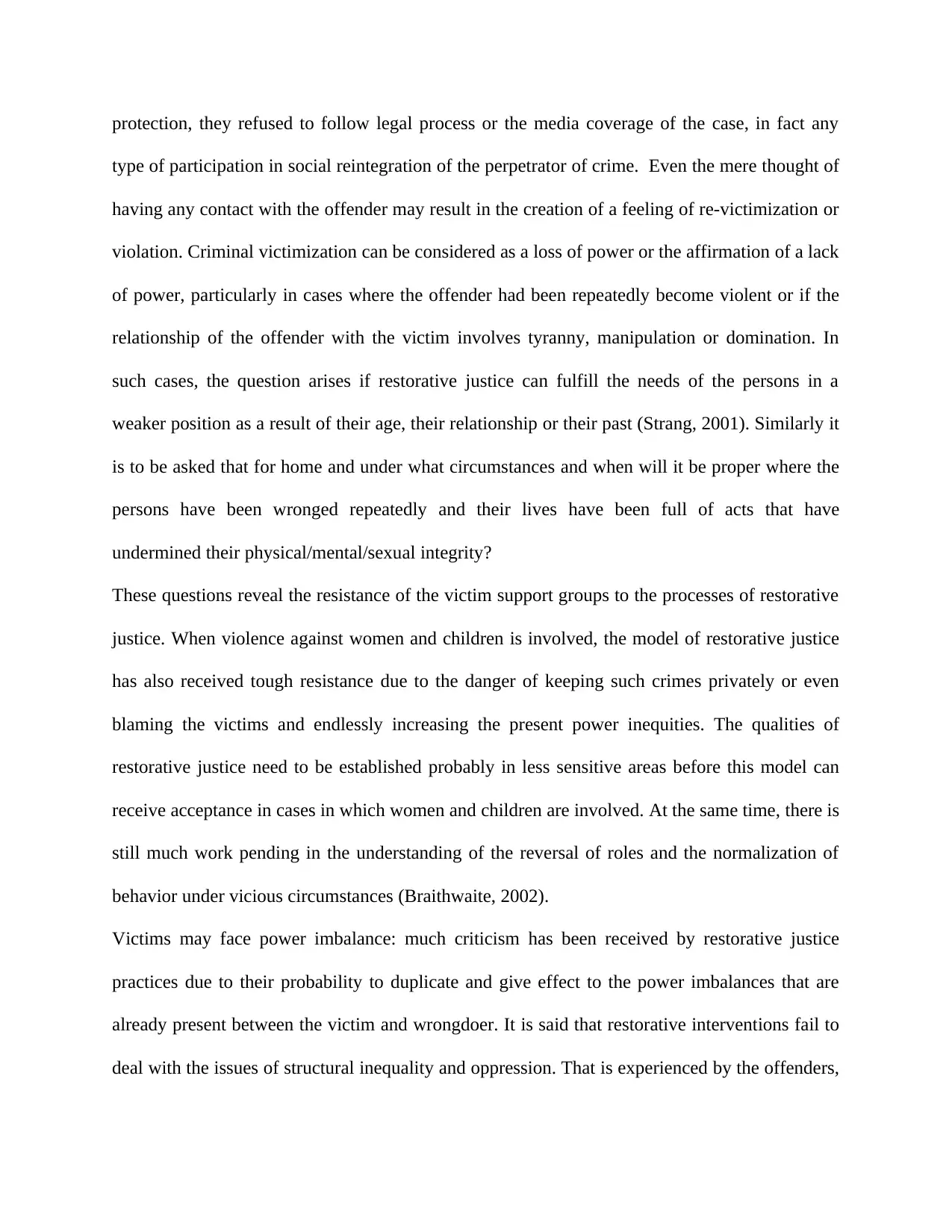
protection, they refused to follow legal process or the media coverage of the case, in fact any
type of participation in social reintegration of the perpetrator of crime. Even the mere thought of
having any contact with the offender may result in the creation of a feeling of re-victimization or
violation. Criminal victimization can be considered as a loss of power or the affirmation of a lack
of power, particularly in cases where the offender had been repeatedly become violent or if the
relationship of the offender with the victim involves tyranny, manipulation or domination. In
such cases, the question arises if restorative justice can fulfill the needs of the persons in a
weaker position as a result of their age, their relationship or their past (Strang, 2001). Similarly it
is to be asked that for home and under what circumstances and when will it be proper where the
persons have been wronged repeatedly and their lives have been full of acts that have
undermined their physical/mental/sexual integrity?
These questions reveal the resistance of the victim support groups to the processes of restorative
justice. When violence against women and children is involved, the model of restorative justice
has also received tough resistance due to the danger of keeping such crimes privately or even
blaming the victims and endlessly increasing the present power inequities. The qualities of
restorative justice need to be established probably in less sensitive areas before this model can
receive acceptance in cases in which women and children are involved. At the same time, there is
still much work pending in the understanding of the reversal of roles and the normalization of
behavior under vicious circumstances (Braithwaite, 2002).
Victims may face power imbalance: much criticism has been received by restorative justice
practices due to their probability to duplicate and give effect to the power imbalances that are
already present between the victim and wrongdoer. It is said that restorative interventions fail to
deal with the issues of structural inequality and oppression. That is experienced by the offenders,
type of participation in social reintegration of the perpetrator of crime. Even the mere thought of
having any contact with the offender may result in the creation of a feeling of re-victimization or
violation. Criminal victimization can be considered as a loss of power or the affirmation of a lack
of power, particularly in cases where the offender had been repeatedly become violent or if the
relationship of the offender with the victim involves tyranny, manipulation or domination. In
such cases, the question arises if restorative justice can fulfill the needs of the persons in a
weaker position as a result of their age, their relationship or their past (Strang, 2001). Similarly it
is to be asked that for home and under what circumstances and when will it be proper where the
persons have been wronged repeatedly and their lives have been full of acts that have
undermined their physical/mental/sexual integrity?
These questions reveal the resistance of the victim support groups to the processes of restorative
justice. When violence against women and children is involved, the model of restorative justice
has also received tough resistance due to the danger of keeping such crimes privately or even
blaming the victims and endlessly increasing the present power inequities. The qualities of
restorative justice need to be established probably in less sensitive areas before this model can
receive acceptance in cases in which women and children are involved. At the same time, there is
still much work pending in the understanding of the reversal of roles and the normalization of
behavior under vicious circumstances (Braithwaite, 2002).
Victims may face power imbalance: much criticism has been received by restorative justice
practices due to their probability to duplicate and give effect to the power imbalances that are
already present between the victim and wrongdoer. It is said that restorative interventions fail to
deal with the issues of structural inequality and oppression. That is experienced by the offenders,
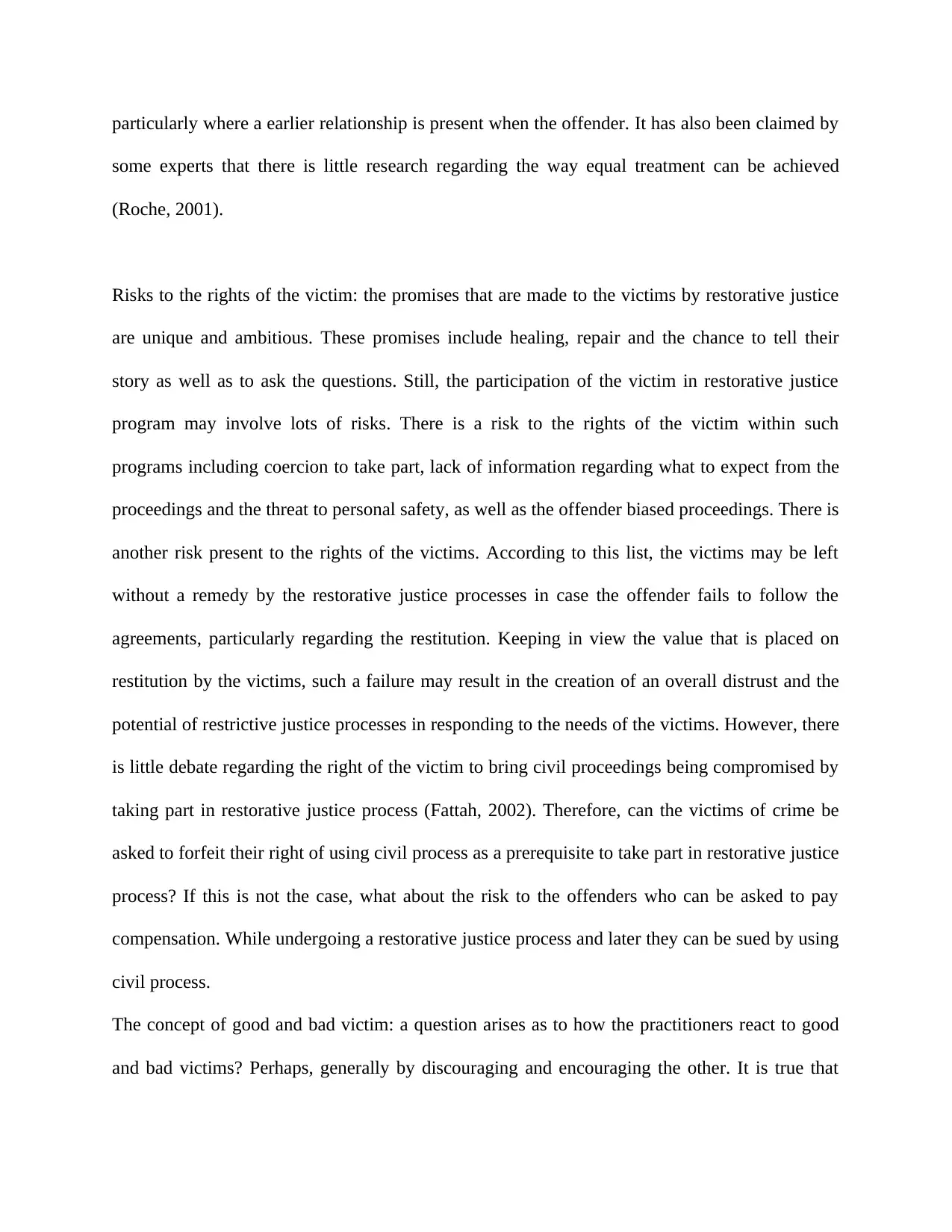
particularly where a earlier relationship is present when the offender. It has also been claimed by
some experts that there is little research regarding the way equal treatment can be achieved
(Roche, 2001).
Risks to the rights of the victim: the promises that are made to the victims by restorative justice
are unique and ambitious. These promises include healing, repair and the chance to tell their
story as well as to ask the questions. Still, the participation of the victim in restorative justice
program may involve lots of risks. There is a risk to the rights of the victim within such
programs including coercion to take part, lack of information regarding what to expect from the
proceedings and the threat to personal safety, as well as the offender biased proceedings. There is
another risk present to the rights of the victims. According to this list, the victims may be left
without a remedy by the restorative justice processes in case the offender fails to follow the
agreements, particularly regarding the restitution. Keeping in view the value that is placed on
restitution by the victims, such a failure may result in the creation of an overall distrust and the
potential of restrictive justice processes in responding to the needs of the victims. However, there
is little debate regarding the right of the victim to bring civil proceedings being compromised by
taking part in restorative justice process (Fattah, 2002). Therefore, can the victims of crime be
asked to forfeit their right of using civil process as a prerequisite to take part in restorative justice
process? If this is not the case, what about the risk to the offenders who can be asked to pay
compensation. While undergoing a restorative justice process and later they can be sued by using
civil process.
The concept of good and bad victim: a question arises as to how the practitioners react to good
and bad victims? Perhaps, generally by discouraging and encouraging the other. It is true that
some experts that there is little research regarding the way equal treatment can be achieved
(Roche, 2001).
Risks to the rights of the victim: the promises that are made to the victims by restorative justice
are unique and ambitious. These promises include healing, repair and the chance to tell their
story as well as to ask the questions. Still, the participation of the victim in restorative justice
program may involve lots of risks. There is a risk to the rights of the victim within such
programs including coercion to take part, lack of information regarding what to expect from the
proceedings and the threat to personal safety, as well as the offender biased proceedings. There is
another risk present to the rights of the victims. According to this list, the victims may be left
without a remedy by the restorative justice processes in case the offender fails to follow the
agreements, particularly regarding the restitution. Keeping in view the value that is placed on
restitution by the victims, such a failure may result in the creation of an overall distrust and the
potential of restrictive justice processes in responding to the needs of the victims. However, there
is little debate regarding the right of the victim to bring civil proceedings being compromised by
taking part in restorative justice process (Fattah, 2002). Therefore, can the victims of crime be
asked to forfeit their right of using civil process as a prerequisite to take part in restorative justice
process? If this is not the case, what about the risk to the offenders who can be asked to pay
compensation. While undergoing a restorative justice process and later they can be sued by using
civil process.
The concept of good and bad victim: a question arises as to how the practitioners react to good
and bad victims? Perhaps, generally by discouraging and encouraging the other. It is true that
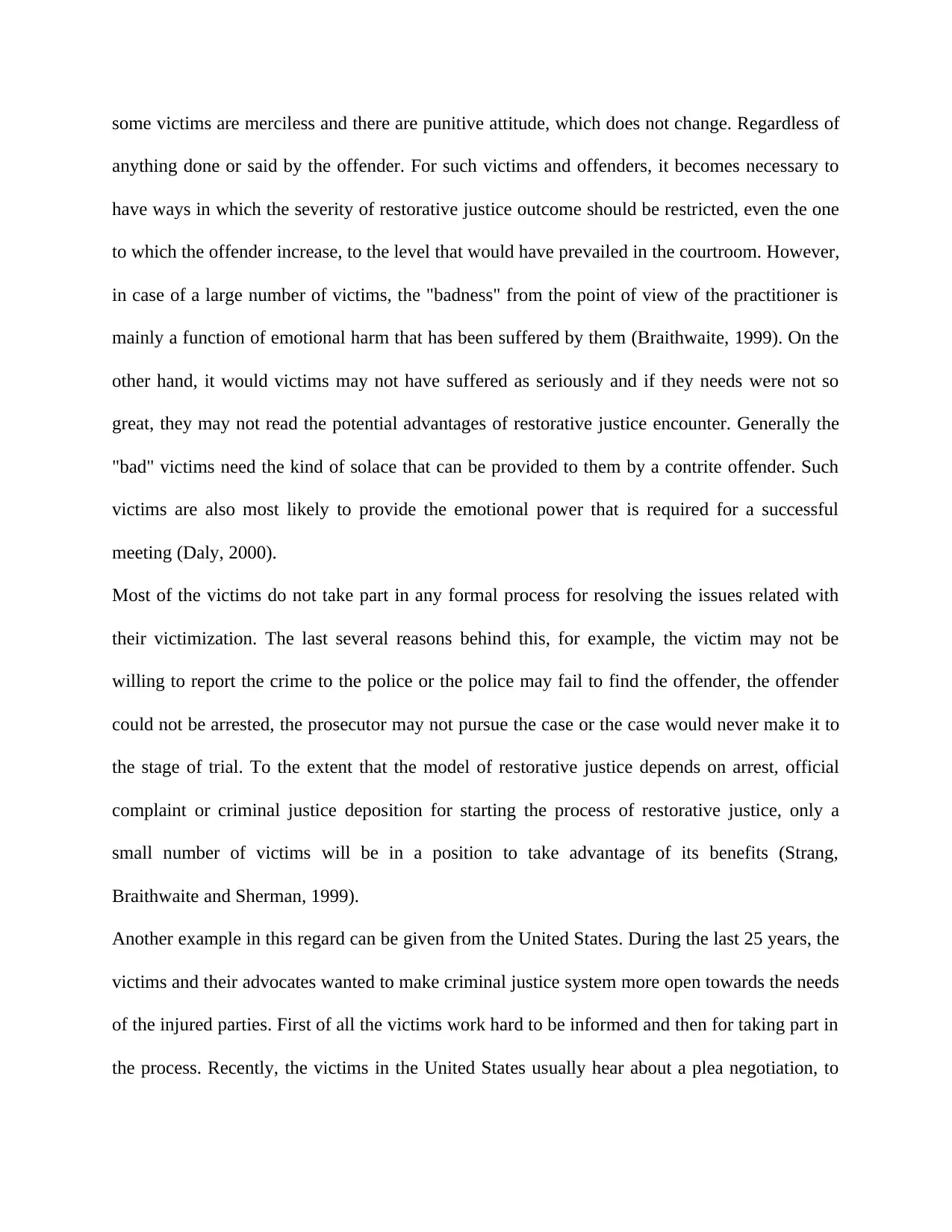
some victims are merciless and there are punitive attitude, which does not change. Regardless of
anything done or said by the offender. For such victims and offenders, it becomes necessary to
have ways in which the severity of restorative justice outcome should be restricted, even the one
to which the offender increase, to the level that would have prevailed in the courtroom. However,
in case of a large number of victims, the "badness" from the point of view of the practitioner is
mainly a function of emotional harm that has been suffered by them (Braithwaite, 1999). On the
other hand, it would victims may not have suffered as seriously and if they needs were not so
great, they may not read the potential advantages of restorative justice encounter. Generally the
"bad" victims need the kind of solace that can be provided to them by a contrite offender. Such
victims are also most likely to provide the emotional power that is required for a successful
meeting (Daly, 2000).
Most of the victims do not take part in any formal process for resolving the issues related with
their victimization. The last several reasons behind this, for example, the victim may not be
willing to report the crime to the police or the police may fail to find the offender, the offender
could not be arrested, the prosecutor may not pursue the case or the case would never make it to
the stage of trial. To the extent that the model of restorative justice depends on arrest, official
complaint or criminal justice deposition for starting the process of restorative justice, only a
small number of victims will be in a position to take advantage of its benefits (Strang,
Braithwaite and Sherman, 1999).
Another example in this regard can be given from the United States. During the last 25 years, the
victims and their advocates wanted to make criminal justice system more open towards the needs
of the injured parties. First of all the victims work hard to be informed and then for taking part in
the process. Recently, the victims in the United States usually hear about a plea negotiation, to
anything done or said by the offender. For such victims and offenders, it becomes necessary to
have ways in which the severity of restorative justice outcome should be restricted, even the one
to which the offender increase, to the level that would have prevailed in the courtroom. However,
in case of a large number of victims, the "badness" from the point of view of the practitioner is
mainly a function of emotional harm that has been suffered by them (Braithwaite, 1999). On the
other hand, it would victims may not have suffered as seriously and if they needs were not so
great, they may not read the potential advantages of restorative justice encounter. Generally the
"bad" victims need the kind of solace that can be provided to them by a contrite offender. Such
victims are also most likely to provide the emotional power that is required for a successful
meeting (Daly, 2000).
Most of the victims do not take part in any formal process for resolving the issues related with
their victimization. The last several reasons behind this, for example, the victim may not be
willing to report the crime to the police or the police may fail to find the offender, the offender
could not be arrested, the prosecutor may not pursue the case or the case would never make it to
the stage of trial. To the extent that the model of restorative justice depends on arrest, official
complaint or criminal justice deposition for starting the process of restorative justice, only a
small number of victims will be in a position to take advantage of its benefits (Strang,
Braithwaite and Sherman, 1999).
Another example in this regard can be given from the United States. During the last 25 years, the
victims and their advocates wanted to make criminal justice system more open towards the needs
of the injured parties. First of all the victims work hard to be informed and then for taking part in
the process. Recently, the victims in the United States usually hear about a plea negotiation, to
Paraphrase This Document
Need a fresh take? Get an instant paraphrase of this document with our AI Paraphraser
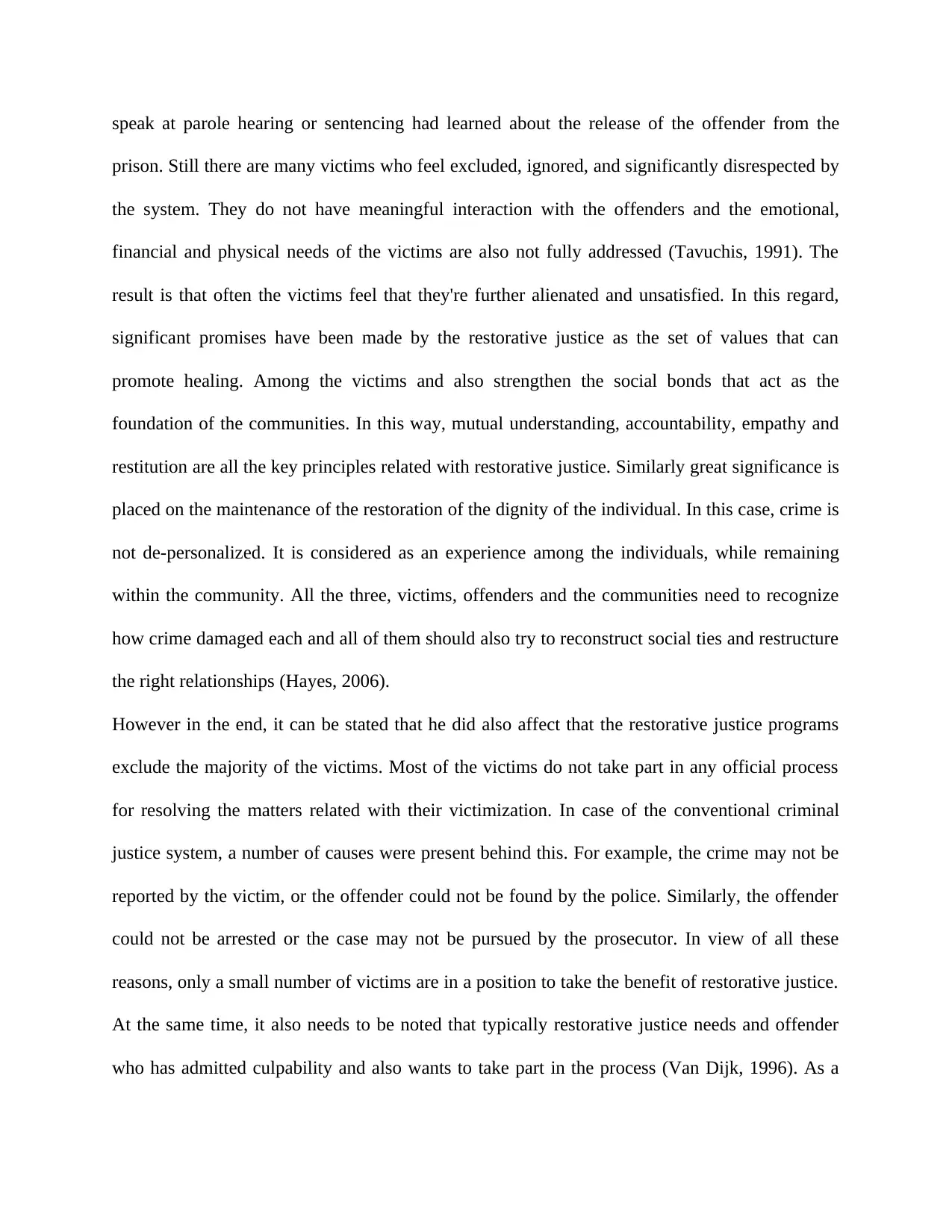
speak at parole hearing or sentencing had learned about the release of the offender from the
prison. Still there are many victims who feel excluded, ignored, and significantly disrespected by
the system. They do not have meaningful interaction with the offenders and the emotional,
financial and physical needs of the victims are also not fully addressed (Tavuchis, 1991). The
result is that often the victims feel that they're further alienated and unsatisfied. In this regard,
significant promises have been made by the restorative justice as the set of values that can
promote healing. Among the victims and also strengthen the social bonds that act as the
foundation of the communities. In this way, mutual understanding, accountability, empathy and
restitution are all the key principles related with restorative justice. Similarly great significance is
placed on the maintenance of the restoration of the dignity of the individual. In this case, crime is
not de-personalized. It is considered as an experience among the individuals, while remaining
within the community. All the three, victims, offenders and the communities need to recognize
how crime damaged each and all of them should also try to reconstruct social ties and restructure
the right relationships (Hayes, 2006).
However in the end, it can be stated that he did also affect that the restorative justice programs
exclude the majority of the victims. Most of the victims do not take part in any official process
for resolving the matters related with their victimization. In case of the conventional criminal
justice system, a number of causes were present behind this. For example, the crime may not be
reported by the victim, or the offender could not be found by the police. Similarly, the offender
could not be arrested or the case may not be pursued by the prosecutor. In view of all these
reasons, only a small number of victims are in a position to take the benefit of restorative justice.
At the same time, it also needs to be noted that typically restorative justice needs and offender
who has admitted culpability and also wants to take part in the process (Van Dijk, 1996). As a
prison. Still there are many victims who feel excluded, ignored, and significantly disrespected by
the system. They do not have meaningful interaction with the offenders and the emotional,
financial and physical needs of the victims are also not fully addressed (Tavuchis, 1991). The
result is that often the victims feel that they're further alienated and unsatisfied. In this regard,
significant promises have been made by the restorative justice as the set of values that can
promote healing. Among the victims and also strengthen the social bonds that act as the
foundation of the communities. In this way, mutual understanding, accountability, empathy and
restitution are all the key principles related with restorative justice. Similarly great significance is
placed on the maintenance of the restoration of the dignity of the individual. In this case, crime is
not de-personalized. It is considered as an experience among the individuals, while remaining
within the community. All the three, victims, offenders and the communities need to recognize
how crime damaged each and all of them should also try to reconstruct social ties and restructure
the right relationships (Hayes, 2006).
However in the end, it can be stated that he did also affect that the restorative justice programs
exclude the majority of the victims. Most of the victims do not take part in any official process
for resolving the matters related with their victimization. In case of the conventional criminal
justice system, a number of causes were present behind this. For example, the crime may not be
reported by the victim, or the offender could not be found by the police. Similarly, the offender
could not be arrested or the case may not be pursued by the prosecutor. In view of all these
reasons, only a small number of victims are in a position to take the benefit of restorative justice.
At the same time, it also needs to be noted that typically restorative justice needs and offender
who has admitted culpability and also wants to take part in the process (Van Dijk, 1996). As a
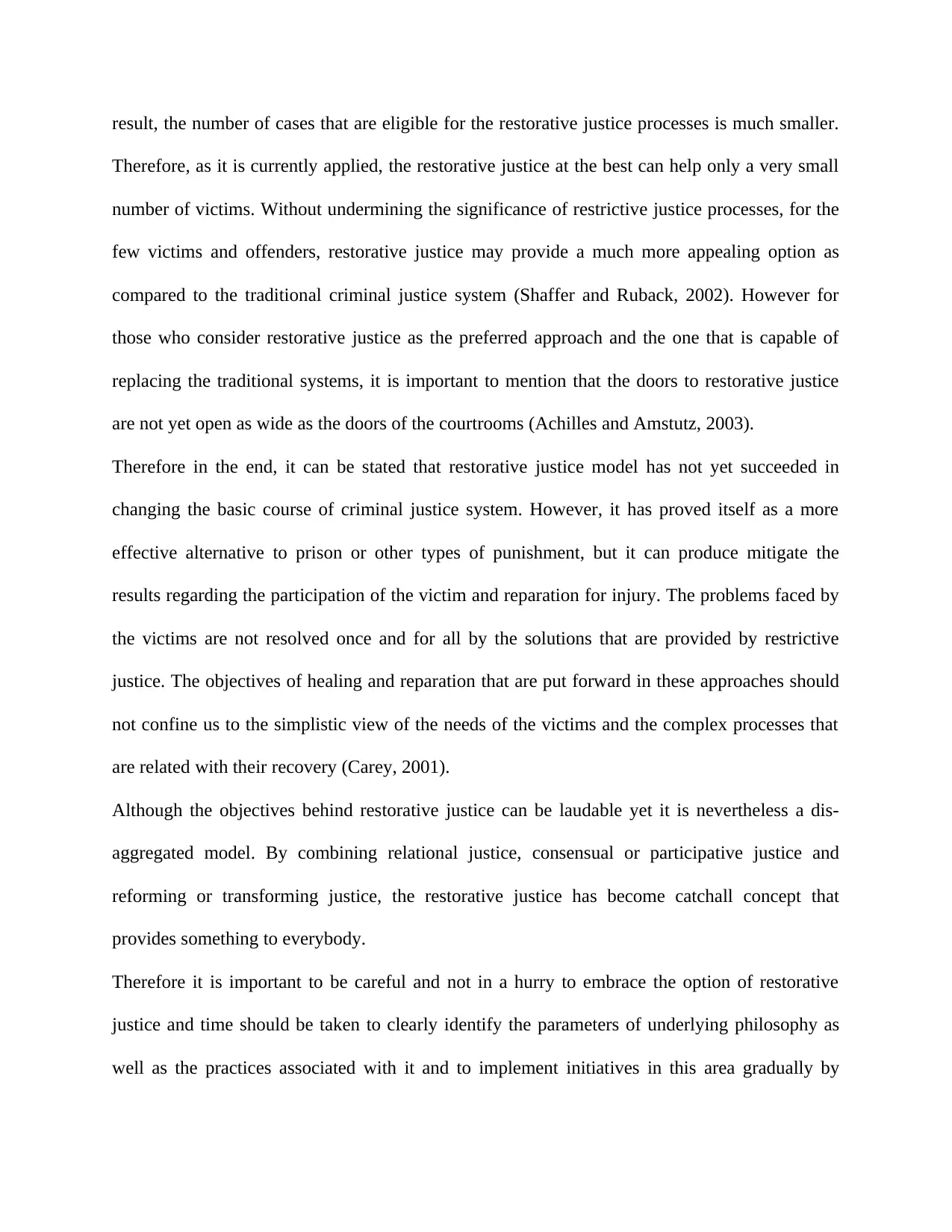
result, the number of cases that are eligible for the restorative justice processes is much smaller.
Therefore, as it is currently applied, the restorative justice at the best can help only a very small
number of victims. Without undermining the significance of restrictive justice processes, for the
few victims and offenders, restorative justice may provide a much more appealing option as
compared to the traditional criminal justice system (Shaffer and Ruback, 2002). However for
those who consider restorative justice as the preferred approach and the one that is capable of
replacing the traditional systems, it is important to mention that the doors to restorative justice
are not yet open as wide as the doors of the courtrooms (Achilles and Amstutz, 2003).
Therefore in the end, it can be stated that restorative justice model has not yet succeeded in
changing the basic course of criminal justice system. However, it has proved itself as a more
effective alternative to prison or other types of punishment, but it can produce mitigate the
results regarding the participation of the victim and reparation for injury. The problems faced by
the victims are not resolved once and for all by the solutions that are provided by restrictive
justice. The objectives of healing and reparation that are put forward in these approaches should
not confine us to the simplistic view of the needs of the victims and the complex processes that
are related with their recovery (Carey, 2001).
Although the objectives behind restorative justice can be laudable yet it is nevertheless a dis-
aggregated model. By combining relational justice, consensual or participative justice and
reforming or transforming justice, the restorative justice has become catchall concept that
provides something to everybody.
Therefore it is important to be careful and not in a hurry to embrace the option of restorative
justice and time should be taken to clearly identify the parameters of underlying philosophy as
well as the practices associated with it and to implement initiatives in this area gradually by
Therefore, as it is currently applied, the restorative justice at the best can help only a very small
number of victims. Without undermining the significance of restrictive justice processes, for the
few victims and offenders, restorative justice may provide a much more appealing option as
compared to the traditional criminal justice system (Shaffer and Ruback, 2002). However for
those who consider restorative justice as the preferred approach and the one that is capable of
replacing the traditional systems, it is important to mention that the doors to restorative justice
are not yet open as wide as the doors of the courtrooms (Achilles and Amstutz, 2003).
Therefore in the end, it can be stated that restorative justice model has not yet succeeded in
changing the basic course of criminal justice system. However, it has proved itself as a more
effective alternative to prison or other types of punishment, but it can produce mitigate the
results regarding the participation of the victim and reparation for injury. The problems faced by
the victims are not resolved once and for all by the solutions that are provided by restrictive
justice. The objectives of healing and reparation that are put forward in these approaches should
not confine us to the simplistic view of the needs of the victims and the complex processes that
are related with their recovery (Carey, 2001).
Although the objectives behind restorative justice can be laudable yet it is nevertheless a dis-
aggregated model. By combining relational justice, consensual or participative justice and
reforming or transforming justice, the restorative justice has become catchall concept that
provides something to everybody.
Therefore it is important to be careful and not in a hurry to embrace the option of restorative
justice and time should be taken to clearly identify the parameters of underlying philosophy as
well as the practices associated with it and to implement initiatives in this area gradually by

adopting a wide range of strategies. It is also important to target best practices, collect data
regarding bigger groups and to consider the long-term effects of these programs.
regarding bigger groups and to consider the long-term effects of these programs.
Secure Best Marks with AI Grader
Need help grading? Try our AI Grader for instant feedback on your assignments.
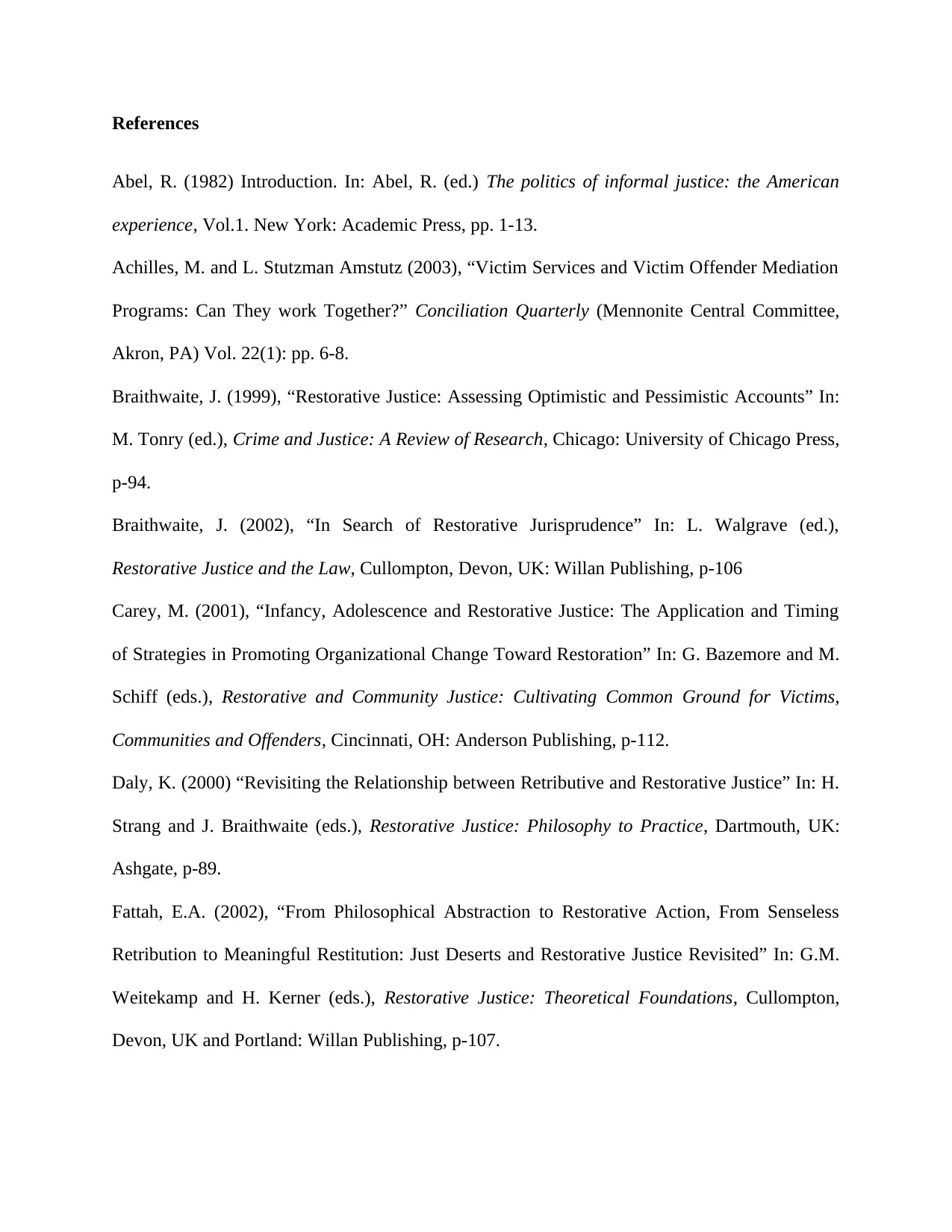
References
Abel, R. (1982) Introduction. In: Abel, R. (ed.) The politics of informal justice: the American
experience, Vol.1. New York: Academic Press, pp. 1-13.
Achilles, M. and L. Stutzman Amstutz (2003), “Victim Services and Victim Offender Mediation
Programs: Can They work Together?” Conciliation Quarterly (Mennonite Central Committee,
Akron, PA) Vol. 22(1): pp. 6-8.
Braithwaite, J. (1999), “Restorative Justice: Assessing Optimistic and Pessimistic Accounts” In:
M. Tonry (ed.), Crime and Justice: A Review of Research, Chicago: University of Chicago Press,
p-94.
Braithwaite, J. (2002), “In Search of Restorative Jurisprudence” In: L. Walgrave (ed.),
Restorative Justice and the Law, Cullompton, Devon, UK: Willan Publishing, p-106
Carey, M. (2001), “Infancy, Adolescence and Restorative Justice: The Application and Timing
of Strategies in Promoting Organizational Change Toward Restoration” In: G. Bazemore and M.
Schiff (eds.), Restorative and Community Justice: Cultivating Common Ground for Victims,
Communities and Offenders, Cincinnati, OH: Anderson Publishing, p-112.
Daly, K. (2000) “Revisiting the Relationship between Retributive and Restorative Justice” In: H.
Strang and J. Braithwaite (eds.), Restorative Justice: Philosophy to Practice, Dartmouth, UK:
Ashgate, p-89.
Fattah, E.A. (2002), “From Philosophical Abstraction to Restorative Action, From Senseless
Retribution to Meaningful Restitution: Just Deserts and Restorative Justice Revisited” In: G.M.
Weitekamp and H. Kerner (eds.), Restorative Justice: Theoretical Foundations, Cullompton,
Devon, UK and Portland: Willan Publishing, p-107.
Abel, R. (1982) Introduction. In: Abel, R. (ed.) The politics of informal justice: the American
experience, Vol.1. New York: Academic Press, pp. 1-13.
Achilles, M. and L. Stutzman Amstutz (2003), “Victim Services and Victim Offender Mediation
Programs: Can They work Together?” Conciliation Quarterly (Mennonite Central Committee,
Akron, PA) Vol. 22(1): pp. 6-8.
Braithwaite, J. (1999), “Restorative Justice: Assessing Optimistic and Pessimistic Accounts” In:
M. Tonry (ed.), Crime and Justice: A Review of Research, Chicago: University of Chicago Press,
p-94.
Braithwaite, J. (2002), “In Search of Restorative Jurisprudence” In: L. Walgrave (ed.),
Restorative Justice and the Law, Cullompton, Devon, UK: Willan Publishing, p-106
Carey, M. (2001), “Infancy, Adolescence and Restorative Justice: The Application and Timing
of Strategies in Promoting Organizational Change Toward Restoration” In: G. Bazemore and M.
Schiff (eds.), Restorative and Community Justice: Cultivating Common Ground for Victims,
Communities and Offenders, Cincinnati, OH: Anderson Publishing, p-112.
Daly, K. (2000) “Revisiting the Relationship between Retributive and Restorative Justice” In: H.
Strang and J. Braithwaite (eds.), Restorative Justice: Philosophy to Practice, Dartmouth, UK:
Ashgate, p-89.
Fattah, E.A. (2002), “From Philosophical Abstraction to Restorative Action, From Senseless
Retribution to Meaningful Restitution: Just Deserts and Restorative Justice Revisited” In: G.M.
Weitekamp and H. Kerner (eds.), Restorative Justice: Theoretical Foundations, Cullompton,
Devon, UK and Portland: Willan Publishing, p-107.
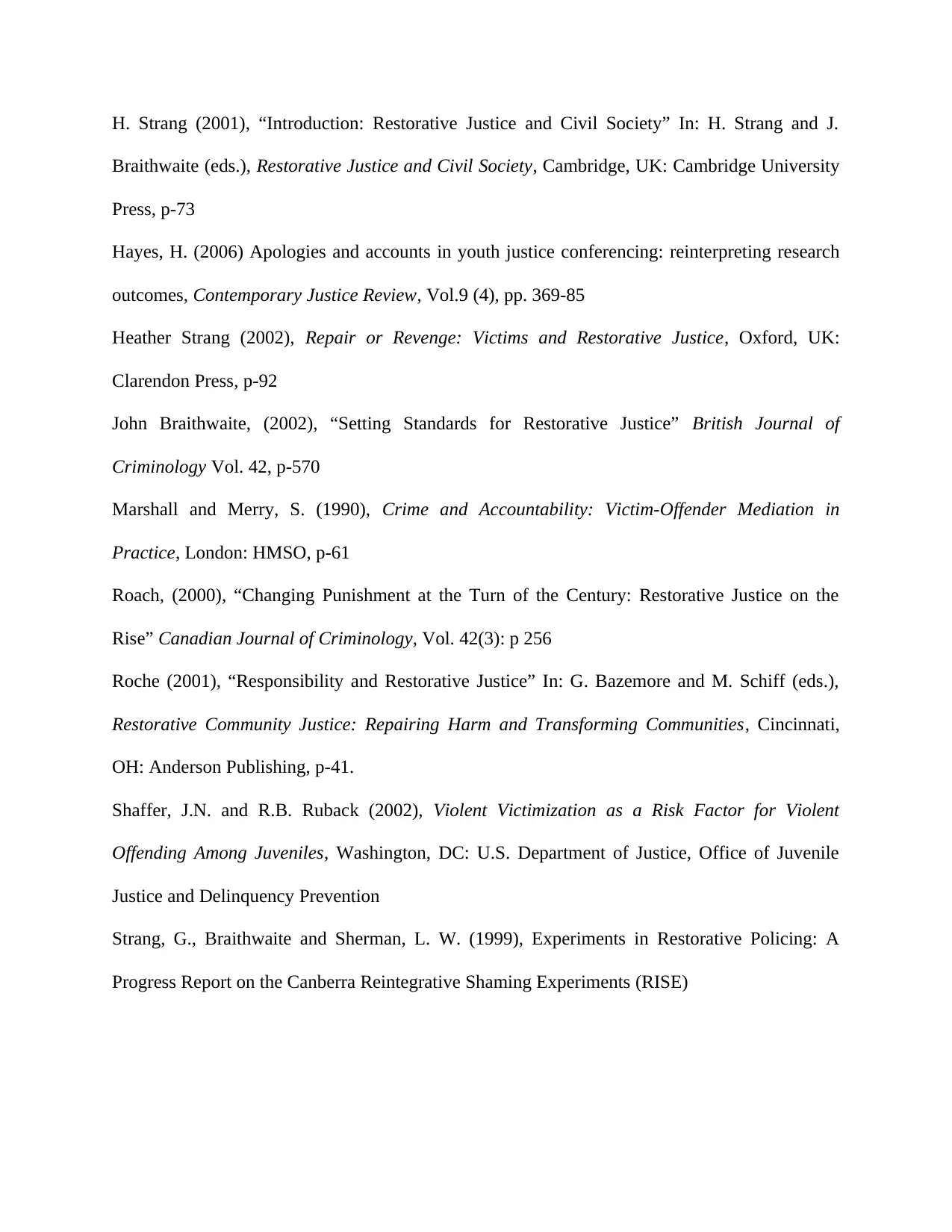
H. Strang (2001), “Introduction: Restorative Justice and Civil Society” In: H. Strang and J.
Braithwaite (eds.), Restorative Justice and Civil Society, Cambridge, UK: Cambridge University
Press, p-73
Hayes, H. (2006) Apologies and accounts in youth justice conferencing: reinterpreting research
outcomes, Contemporary Justice Review, Vol.9 (4), pp. 369-85
Heather Strang (2002), Repair or Revenge: Victims and Restorative Justice, Oxford, UK:
Clarendon Press, p-92
John Braithwaite, (2002), “Setting Standards for Restorative Justice” British Journal of
Criminology Vol. 42, p-570
Marshall and Merry, S. (1990), Crime and Accountability: Victim-Offender Mediation in
Practice, London: HMSO, p-61
Roach, (2000), “Changing Punishment at the Turn of the Century: Restorative Justice on the
Rise” Canadian Journal of Criminology, Vol. 42(3): p 256
Roche (2001), “Responsibility and Restorative Justice” In: G. Bazemore and M. Schiff (eds.),
Restorative Community Justice: Repairing Harm and Transforming Communities, Cincinnati,
OH: Anderson Publishing, p-41.
Shaffer, J.N. and R.B. Ruback (2002), Violent Victimization as a Risk Factor for Violent
Offending Among Juveniles, Washington, DC: U.S. Department of Justice, Office of Juvenile
Justice and Delinquency Prevention
Strang, G., Braithwaite and Sherman, L. W. (1999), Experiments in Restorative Policing: A
Progress Report on the Canberra Reintegrative Shaming Experiments (RISE)
Braithwaite (eds.), Restorative Justice and Civil Society, Cambridge, UK: Cambridge University
Press, p-73
Hayes, H. (2006) Apologies and accounts in youth justice conferencing: reinterpreting research
outcomes, Contemporary Justice Review, Vol.9 (4), pp. 369-85
Heather Strang (2002), Repair or Revenge: Victims and Restorative Justice, Oxford, UK:
Clarendon Press, p-92
John Braithwaite, (2002), “Setting Standards for Restorative Justice” British Journal of
Criminology Vol. 42, p-570
Marshall and Merry, S. (1990), Crime and Accountability: Victim-Offender Mediation in
Practice, London: HMSO, p-61
Roach, (2000), “Changing Punishment at the Turn of the Century: Restorative Justice on the
Rise” Canadian Journal of Criminology, Vol. 42(3): p 256
Roche (2001), “Responsibility and Restorative Justice” In: G. Bazemore and M. Schiff (eds.),
Restorative Community Justice: Repairing Harm and Transforming Communities, Cincinnati,
OH: Anderson Publishing, p-41.
Shaffer, J.N. and R.B. Ruback (2002), Violent Victimization as a Risk Factor for Violent
Offending Among Juveniles, Washington, DC: U.S. Department of Justice, Office of Juvenile
Justice and Delinquency Prevention
Strang, G., Braithwaite and Sherman, L. W. (1999), Experiments in Restorative Policing: A
Progress Report on the Canberra Reintegrative Shaming Experiments (RISE)
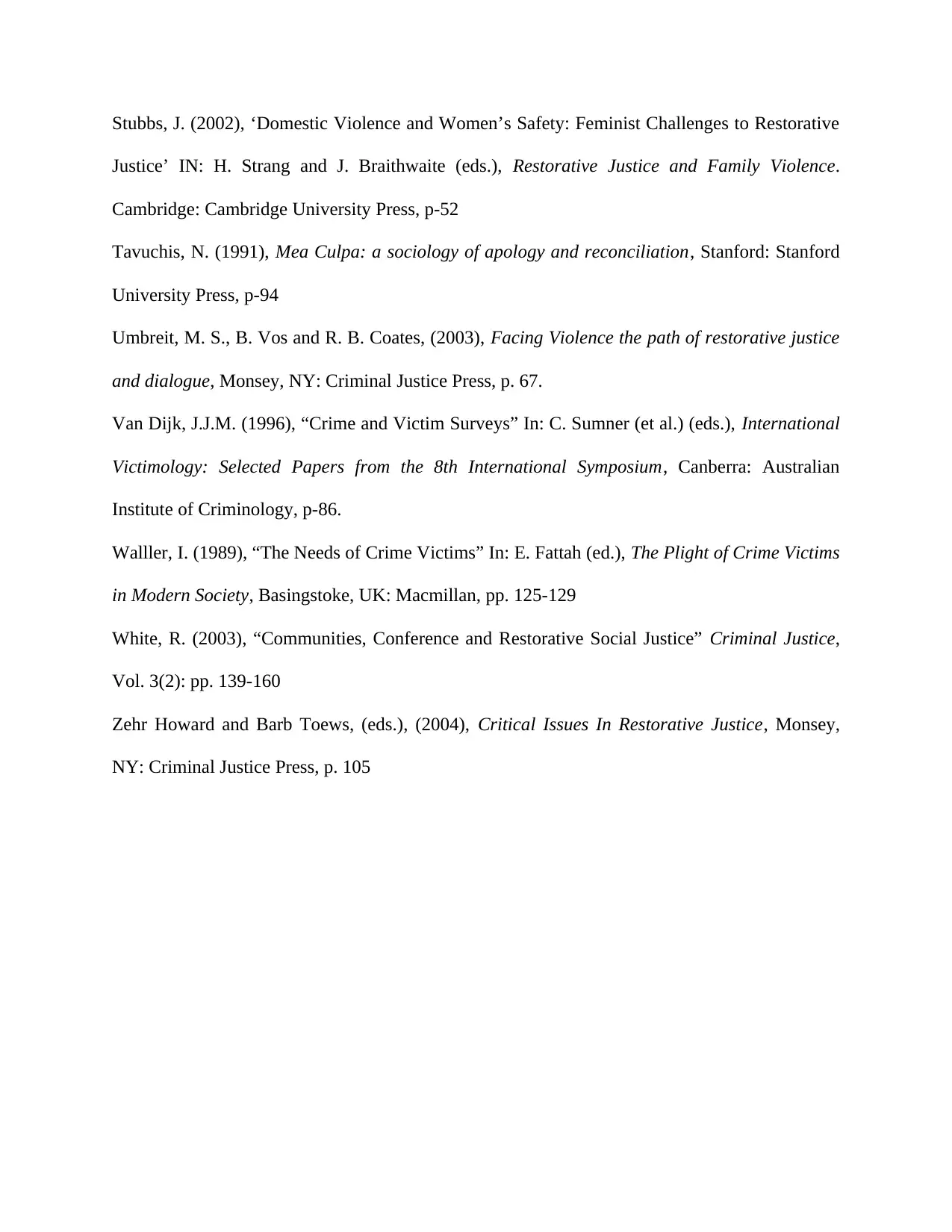
Stubbs, J. (2002), ‘Domestic Violence and Women’s Safety: Feminist Challenges to Restorative
Justice’ IN: H. Strang and J. Braithwaite (eds.), Restorative Justice and Family Violence.
Cambridge: Cambridge University Press, p-52
Tavuchis, N. (1991), Mea Culpa: a sociology of apology and reconciliation, Stanford: Stanford
University Press, p-94
Umbreit, M. S., B. Vos and R. B. Coates, (2003), Facing Violence the path of restorative justice
and dialogue, Monsey, NY: Criminal Justice Press, p. 67.
Van Dijk, J.J.M. (1996), “Crime and Victim Surveys” In: C. Sumner (et al.) (eds.), International
Victimology: Selected Papers from the 8th International Symposium, Canberra: Australian
Institute of Criminology, p-86.
Walller, I. (1989), “The Needs of Crime Victims” In: E. Fattah (ed.), The Plight of Crime Victims
in Modern Society, Basingstoke, UK: Macmillan, pp. 125-129
White, R. (2003), “Communities, Conference and Restorative Social Justice” Criminal Justice,
Vol. 3(2): pp. 139-160
Zehr Howard and Barb Toews, (eds.), (2004), Critical Issues In Restorative Justice, Monsey,
NY: Criminal Justice Press, p. 105
Justice’ IN: H. Strang and J. Braithwaite (eds.), Restorative Justice and Family Violence.
Cambridge: Cambridge University Press, p-52
Tavuchis, N. (1991), Mea Culpa: a sociology of apology and reconciliation, Stanford: Stanford
University Press, p-94
Umbreit, M. S., B. Vos and R. B. Coates, (2003), Facing Violence the path of restorative justice
and dialogue, Monsey, NY: Criminal Justice Press, p. 67.
Van Dijk, J.J.M. (1996), “Crime and Victim Surveys” In: C. Sumner (et al.) (eds.), International
Victimology: Selected Papers from the 8th International Symposium, Canberra: Australian
Institute of Criminology, p-86.
Walller, I. (1989), “The Needs of Crime Victims” In: E. Fattah (ed.), The Plight of Crime Victims
in Modern Society, Basingstoke, UK: Macmillan, pp. 125-129
White, R. (2003), “Communities, Conference and Restorative Social Justice” Criminal Justice,
Vol. 3(2): pp. 139-160
Zehr Howard and Barb Toews, (eds.), (2004), Critical Issues In Restorative Justice, Monsey,
NY: Criminal Justice Press, p. 105
1 out of 13
Related Documents
Your All-in-One AI-Powered Toolkit for Academic Success.
+13062052269
info@desklib.com
Available 24*7 on WhatsApp / Email
![[object Object]](/_next/static/media/star-bottom.7253800d.svg)
Unlock your academic potential
© 2024 | Zucol Services PVT LTD | All rights reserved.




